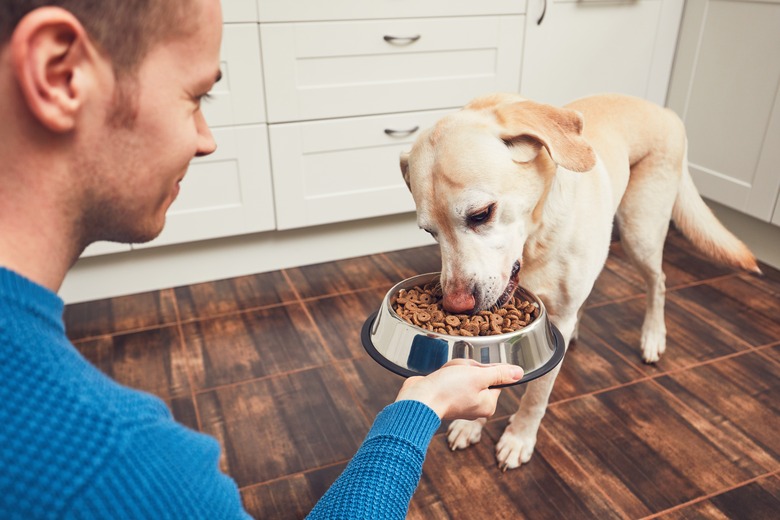How To Make Homemade Dog Food For Dogs With Allergies
We may receive a commission on purchases made from links.
Cuteness may earn compensation through affiliate links in this article.
Excess scratching, hives, hair loss, rashes, or ear and foot infections could be signs that your dog is suffering from food sensitivities or allergies. In some cases, your pup might even experience gastrointestinal issues such as vomiting and diarrhea. While specialized hypoallergenic and prescription dog food are readily available online and in pet stores, you might prefer to develop your own homemade dog food for allergies. After all, you will have more control over the ingredients you're feeding your dog, bypassing hard-to-pronounce, chemically-laden additives.
Narrow down the causes
Narrow down the causes
First, you'll want to rule out other possible allergy triggers, such as flea bites, dust, pollen, grass, or mold. When a dog is allergic to a certain type of food, her intestines might be inflamed, leading to bacterial or yeast overgrowth, which can affect other parts of her body, especially her rear and ears.
However, because food-related allergies are not as common in dogs as people think, your pup might be reacting to food sensitivities instead. The best way to diagnose food allergies is through a vet-supervised elimination diet, essentially a closely monitored diet of a handful of ingredients over a span of 12 weeks. Work closely with your vet to ensure your dog gets sufficient calories and nutrition during this time.
Eliminate common allergens
Eliminate common allergens
The most obvious way to treat allergies is to avoid the triggers, which you can determine by limiting the ingredients your pet ingests and observing his reaction to them. According to a 2016 study published in BMC Veterinary Research, dogs are more likely to be allergic to beef, dairy products, chicken, and wheat. Pick a protein source that your dog has not previously consumed, such as venison, rabbit, salmon, or lamb. Then pair the protein with nutrient-dense, green, leafy vegetables such as spinach, kale, broccoli, and chard.
Or add the protein to healthful carbs like brown rice, oats, barley, rye, or boiled or steamed sweet potato (just a small amount). It takes about three months for your pet's skin issues to clear. Once your pup shows signs of improvement, you can slowly add in more ingredients and monitor if any new symptoms pop up. During the elimination period, avoid feeding your dog any treats or table scraps, and make sure your kitchen garbage is properly secured.
Homemade dog food recipes
Homemade dog food recipes
Like humans, dogs are omnivores, so a balanced diet of protein, fat, carbs, and fiber is essential. There are many schools of thought when it comes to the macros of your dog's food. If you suspect your dog might be allergic to grains, you might want to feed her a high protein, moderate fat, and vegetable/fruit combo. If you want to introduce your dog to a raw diet to maximize nutritional input, make sure you're sourcing the meat from reliable stores to avoid possible contamination.
Each dog's metabolic rate and activity level are different but, in general, the volume of food you feed your pup should be about 2.5-to-3-percent of her weight. So for a midsize dog around 35 pounds, you should feed her slightly less than 1 pound of cooked food. Salt, pepper, sugar, and other seasonings are not recommended. Serve the food at room temperature and avoid the microwave. Before you start your dog on any new food regime, you should consult your vet or trusted pet nutritionist on her specific needs.
Additional supplements
Additional supplements
In addition to coming up with the right macro combination, it's also important to add supplements such as calcium and Omega-3 fatty acids to your homemade dog food for itchy skin. Plain yogurt can be a good source of calcium and protein, and its probiotic cultures can be beneficial to your dog's digestion. Make sure the brand has no added sugar or any artificial sweeteners or flavorings. Some dogs may be lactose intolerant, so stop feeding your dog yogurt if he develops symptoms like diarrhea, gas, or vomiting. Another good source of calcium is powdered eggshells. Essential fatty acids from marine fish oil and flaxseed oil can also help with skin inflammation.
Commercial diets for allergies
Commercial diets for allergies
Monitoring your dog's caloric intake and other nutrients over the span of many weeks requires a lot of extra effort. if this seems daunting, the answer might be as simple as giving your dog a commercially-prepared formula specially designed for dogs with allergies.
Royal Canin Veterinary Diet features rabbit, hydrolyzed soy, and potato — foods that rarely cause sensitivities in dogs. Get a prescription from your vet for this limited-ingredient diet.
Or, give Zignature Small Bites made particularly for little dogs with dietary sensitivities. The food comes derives from less common protein sources such as duck, kangaroo, and trout. You won't find common allergens such as chicken, grains, gluten, soy, or dairy but will find wholesome ingredients modeled after a dog's natural diet.
References
- BMC Veterinary Research: Critically appraised topic on adverse food reactions of companion animals (2): common food allergen sources in dogs and cats
- Journal of Animal Physiology and Animal Nutrition: Macronutrient intake of dogs, self‐selecting diets varying in composition offered ad libitum
- Modern Dog: DIY Eat—Eggshell Powder
